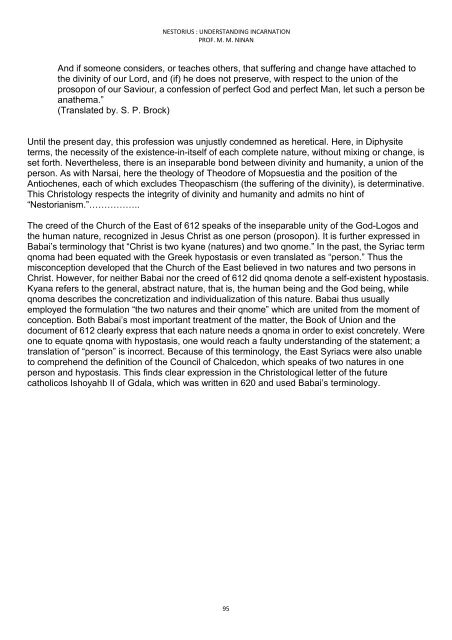Nestorius
Create successful ePaper yourself
Turn your PDF publications into a flip-book with our unique Google optimized e-Paper software.
NESTORIUS : UNDERSTANDING INCARNATION<br />
PROF. M. M. NINAN<br />
And if someone considers, or teaches others, that suffering and change have attached to<br />
the divinity of our Lord, and (if) he does not preserve, with respect to the union of the<br />
prosopon of our Saviour, a confession of perfect God and perfect Man, let such a person be<br />
anathema.”<br />
(Translated by. S. P. Brock)<br />
Until the present day, this profession was unjustly condemned as heretical. Here, in Diphysite<br />
terms, the necessity of the existence-in-itself of each complete nature, without mixing or change, is<br />
set forth. Nevertheless, there is an inseparable bond between divinity and humanity, a union of the<br />
person. As with Narsai, here the theology of Theodore of Mopsuestia and the position of the<br />
Antiochenes, each of which excludes Theopaschism (the suffering of the divinity), is determinative.<br />
This Christology respects the integrity of divinity and humanity and admits no hint of<br />
“Nestorianism.”……………..<br />
The creed of the Church of the East of 612 speaks of the inseparable unity of the God-Logos and<br />
the human nature, recognized in Jesus Christ as one person (prosopon). It is further expressed in<br />
Babai’s terminology that “Christ is two kyane (natures) and two qnome.” In the past, the Syriac term<br />
qnoma had been equated with the Greek hypostasis or even translated as “person.” Thus the<br />
misconception developed that the Church of the East believed in two natures and two persons in<br />
Christ. However, for neither Babai nor the creed of 612 did qnoma denote a self-existent hypostasis.<br />
Kyana refers to the general, abstract nature, that is, the human being and the God being, while<br />
qnoma describes the concretization and individualization of this nature. Babai thus usually<br />
employed the formulation “the two natures and their qnome” which are united from the moment of<br />
conception. Both Babai’s most important treatment of the matter, the Book of Union and the<br />
document of 612 clearly express that each nature needs a qnoma in order to exist concretely. Were<br />
one to equate qnoma with hypostasis, one would reach a faulty understanding of the statement; a<br />
translation of “person” is incorrect. Because of this terminology, the East Syriacs were also unable<br />
to comprehend the definition of the Council of Chalcedon, which speaks of two natures in one<br />
person and hypostasis. This finds clear expression in the Christological letter of the future<br />
catholicos Ishoyahb II of Gdala, which was written in 620 and used Babai’s terminology.<br />
95

















